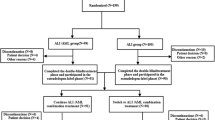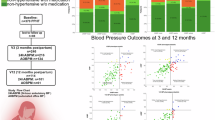Abstract
The effect of olmesartan, an inverse angiotensin II type 1 receptor blocker (ARB), on oxidative stress in hemodialysis (HD) patients is not fully understood, and has not been widely investigated in vitro or in vivo. We determined the amount of oxidized albumin and albumin hydroperoxides formed during incubation in the absence and presence of olmesartan by high-performance liquid chromatography (HPLC) and by a ferrous oxidation xylenol assay in an in vitro study. Six hypertensive HD patients were treated with 40 mg of olmesartan once daily, and blood pressure monitoring (BPM) was performed after 0, 4, and 8 weeks of treatment. The ratio of oxidized to unoxidized albumin was also determined. The oxidized albumin ratios and levels of albumin hydroperoxides were significantly decreased in a concentration-dependent manner in the presence of olmesartan, compared with the absence of olmesartan (p<0.05) in in vitro studies. In HD patients, olmesartan also significantly reduced systolic and diastolic blood pressure after 4 weeks, with a further significant decrease after 8 weeks. The ratio of oxidized to unoxidized albumin was markedly decreased after 4 weeks and these lower levels were maintained at 8 weeks. Olmesartan effectively lowered the extent of oxidation of albumin in both in vitro and in vivo studies, and this effect might confer benefits beyond a reduction in blood pressure.
Similar content being viewed by others
Article PDF
References
Suzuki H : Treatment of hypertension in chronic renal insufficiency. Intern Med 2000; 39: 773–777.
Suzuki H : Angiotensin type 1 receptor blockers in chronic kidney disease. Contrib Nephrol 2004; 143: 159–166.
Okada K, Hirano T, Ran J, Adachi M : Olmesartan medoxomil, an angiotensin II receptor blocker ameliorates insulin resistance and decreases triglyceride production in fructosefed rats. Hypertens Res 2004; 27: 293–299.
Mizuno M, Sada T, Kato M, Koike H : Renoprotective effects of blockade of angiotensin II AT1 receptors in an animal model of type 2 diabetes. Hypertens Res 2002; 25: 271–278.
Martina B, Dieterle T, Sigle JP, Surber C, Battegay E : Effects of telmisartan and losartan on left ventricular mass in mild-to-moderate hypertension. A randomized, double-blind trial. Cardiology 2003; 99: 169–170.
Koh KK, Ahn JY, Han SH, et al: Pleiotropic effects of angiotensin II receptor blocker in hypertensive patients. J Am Coll Cardiol 2003; 42: 905–910.
Griendling KK, Minieri CA, Ollerenshaw JD, Alexander RW : Angiotensin II stimulates NADH and NADPH oxidase activity in cultured vascular smooth muscle cells. Circ Res 1994; 74: 1141–1148.
Ruiz-Ortega M, Lorenzo O, Ruperez M, Konig S, Wittig B, Egido J : Angiotensin II activates nuclear transcription factor κB through AT1 and AT2 in vascular smooth muscle cells: molecular mechanisms. Circ Res 2000; 86: 1266–1272.
Tschudi MR, Mesaros S, Luscher TF, Malinski T : Direct in situ measurement of nitric oxide in mesenteric resistance arteries: increased decomposition by superoxide in hypertension. Hypertension 1996; 27: 32–35.
Weiss D, Kools JJ, Taylor WR : Angiotensin II–induced hypertension accelerates the development of atherosclerosis in ApoE-deficient mice. Circulation 2001; 103: 448–454.
Haller H, Viberti GC, Mimran A, et al: Preventing microalbuminuria in patients with diabetes: rationale and design of the Randomised Olmesartan and Diabetes Microalbuminuria Prevention (ROADMAP) study. J Hypertens 2006; 24: 403–408.
Yamaguchi K, Ura N, Murakami H, et al: Olmesartan ameliorates insulin sensitivity by modulating tumor necrosis factor-alpha and cyclic AMP in skeletal muscle. Hypertens Res 2005; 28: 773–778.
Izuhara Y, Nangaku M, Inagi R, et al: Renoprotective properties of angiotensin receptor blockers beyond blood pressure lowering. J Am Soc Nephrol 2005; 16: 3631–3641.
Yuan Z, Nimata M, Okabe TA, et al: Olmesartan, a novel AT1 antagonist, suppresses cytotoxic myocardial injury in autoimmune heart failure. Am J Physiol Heart Circ Physiol 2005; 289: H1147–H1152.
Miyata T, van Ypersele de Strihou C, Ueda Y, et al: Angiotensin II receptor antagonists and angiotensin-converting enzyme inhibitors lower in vitro the formation of advanced glycation end products: biochemical mechanisms. J Am Soc Nephrol 2002; 13: 2478–2487.
Anraku M, Kitamura K, Shinohara A, et al: Intravenous iron administration induces oxidation of serum albumin in hemodialysis patients. Kidney Int 2004; 66: 841–848.
Shimada H, Kitamura K, Anraku M, et al: Effect of telmisartan on ambulatory blood pressure monitoring, plasma brain natriuretic peptide, and oxidative status of serum albumin in hemodialysis patients. Hypertens Res 2005; 28: 987–994.
Mera K, Anraku M, Kitamura K, et al: Oxidation and carboxy methyl lysine-modification of albumin: possible involvement in the progression of oxidative stress in hemodialysis patients. Hypertens Res 2005; 28: 973–980.
Gay CA, Gebicki JM : Measurement of protein and lipid hydroperoxides in biological systems by the ferric-xylenol orange method. Anal Biochem 2003; 315: 29–35.
Shacter E, Williams JA, Lim M, Levine RL : Differential susceptibility of plasma proteins to oxidative modification: examination by western blot immunoassay. Free Radic Biol Med 1994; 17: 429–437.
Descamps-Latscha B, Witko-Sarsat V : Importance of oxidatively modified proteins in chronic renal failure. Kidney Int 2001; 59 ( Suppl 78): S108–S113.
Daschner M, Lenhartz H, Botticher D, et al: Influence of dialysis on plasma lipid peroxidation products and antioxidant levels. Kidney Int 1996; 50: 1268–1272.
Witko-Sarsat V, Gausson V, Nguyen AT, et al: AOPP-induced activation of human neutrophil and monocyte oxidative metabolism: a potential target for N-acetylcysteine treatment in dialysis patients. Kidney Int 2003; 64: 82–91.
Witko-Sarsat V, Gausson V, Descamps-Latscha B : Are advanced oxidation protein products potential uremic toxins? Kidney Int 2003; 63 ( Suppl 84): S11–S14.
Witko-Sarsat V, Friedlander M, Capeillere-Blandin C, et al: Advanced oxidation protein products as a novel marker of oxidative stress in uremia. Kidney Int 1996; 49: 1304–1313.
Odetti P, Garibaldi S, Gurreri G, Aragno I, Dapino D : Protein oxidation in hemodialysis and kidney transplantation. Metabolism 1996; 45: 1319–1322.
Himmelfarb J, McMonagle E : Albumin is the major plasma protein target of oxidant stress in uremia. Kidney Int 2001; 60: 358–363.
Bourdon E, Loreau N, Blache D : Glucose and free radicals impair the antioxidant properties of serum albumin. FASEB J 1999; 13: 233–244.
Gebicki JM : Protein hydroperoxides as new reactive oxygen species. Redox Rep 1997; 3: 99–110.
Mera K, Anraku M, Kitamura K, Nakajou K, Maruyama T, Otagiri M : The structure and function of oxidized albumin in hemodialysis patients: its role in elevated oxidative stress via neutrophil burst. Biochem Biophys Res Commun 2005; 334: 1322–1338.
Sogami M, Nagaoka S, Era S, Honda M, Noguchi K : Resolution of human mercapt- and nonmercaptalbumin by high-performance liquid chromatography. Int J Pept Protein Res 1984; 24: 96–103.
Hayakawa A, Kuwata K, Era S, et al: Alteration of redox state of human serum albumin in patients under anesthesia and invasive surgery. J Chromatogr B Biomed Sci Appl 1997; 698: 27–33.
Sogami M, Era S, Nagaoka S, et al: High-performance liquid chromatographic studies on non-mercapt in equilibrium with mercapt conversion of human serum albumin. J Chromatogr 1985; 332: 19–27.
Suzuki E, Yasuda K, Takeda N, et al: Increased oxidized form of human serum albumin in patients with diabetes mellitus. Diabetes Res Clin Pract 1992; 18: 153–158.
Soejima A, Kaneda F, Manno S, et al: Useful markers for detecting decreased serum antioxidant activity in hemodialysis patients. Am J Kidney Dis 2002; 39: 1040–1046.
Soriani M, Pietraforte D, Minetti M : Antioxidant potential of anaerobic human plasma: role of serum albumin and thiols as scavengers of carbon radicals. Arch Biochem Biophys 1994; 312: 180–188.
Stamler JS, Simon DI, Osborne JA, et al: S-Nitrosylation of proteins with nitric oxide: synthesis and characterization of biologically active compounds. Proc Natl Acad Sci U S A 1992; 89: 444–448.
Unger T, Culman J, Gohlke P : Angiotensin II receptor blockade and end-organ protection: pharmacological rationale and evidence. J Hypertens Suppl 1998; 16: S3–S9.
Rajagopalan S, Duquaine D, King S, Pitt B, Patel P : Mineralocorticoid receptor antagonism in experimental atherosclerosis. Circulation 2002; 105: 2212–2216.
Yao L, Kobori H, Rahman M, et al: Olmesartan improves endothelin-induced hypertension and oxidative stress in rats. Hypertens Res 2004; 27: 493–500.
Author information
Authors and Affiliations
Corresponding author
Rights and permissions
About this article
Cite this article
Kadowaki, D., Anraku, M., Tasaki, Y. et al. Effect of Olmesartan on Oxidative Stress in Hemodialysis Patients. Hypertens Res 30, 395–402 (2007). https://doi.org/10.1291/hypres.30.395
Received:
Accepted:
Issue date:
DOI: https://doi.org/10.1291/hypres.30.395
Keywords
This article is cited by
-
Olmesartan protects endothelial cells against oxidative stress-mediated cellular injury
Clinical and Experimental Nephrology (2015)



